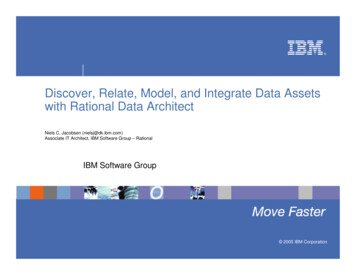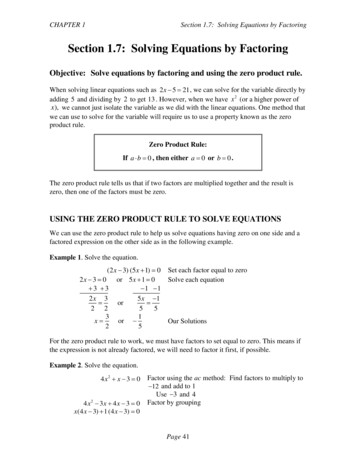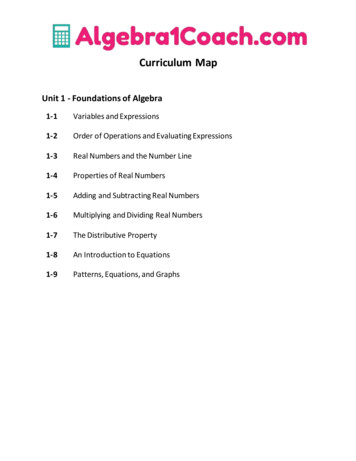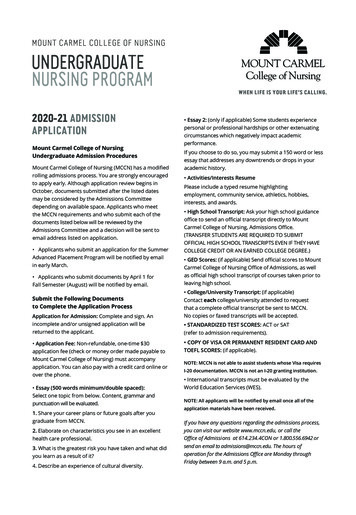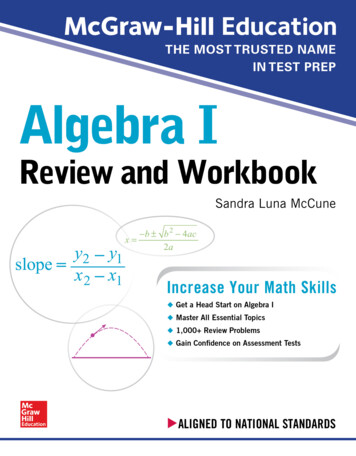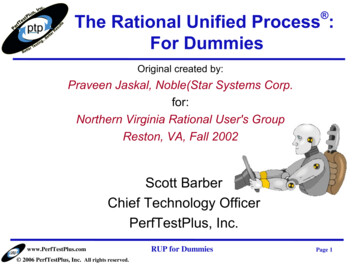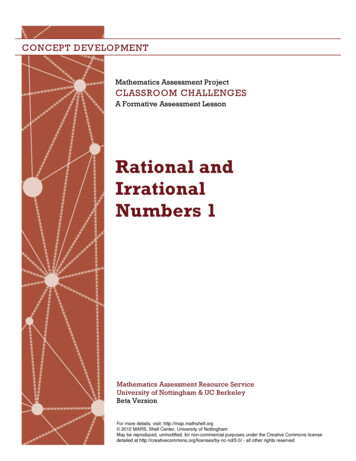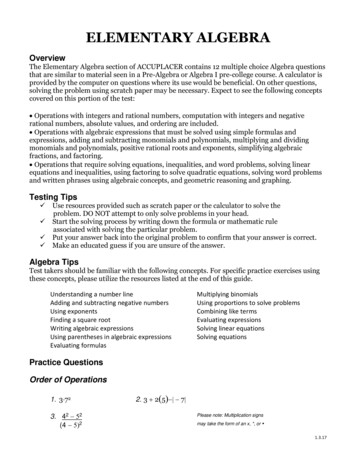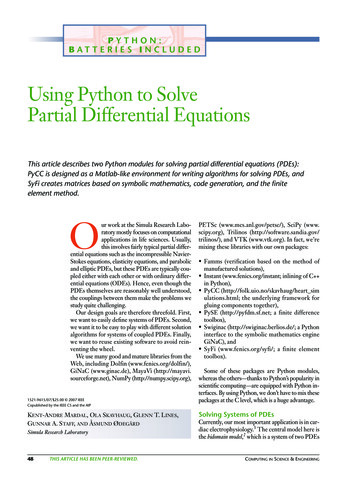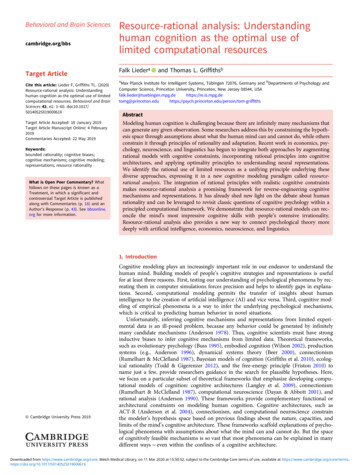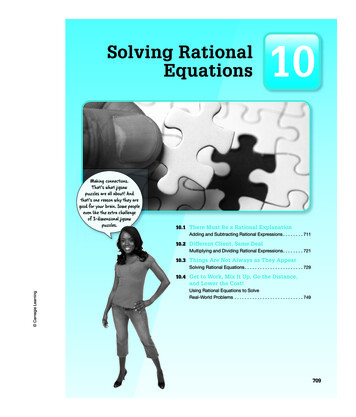
Transcription
Solving RationalEquationsMaking connections.That’s what jigsawpuzzles are all about! Andthat’s one reason why they aregood for your brain. Some peopleeven like the extra challengeof 3-dimensional jigsawpuzzles.1010.1 There Must Be a Rational ExplanationAdding and Subtracting Rational Expressions . . . . . . . . 71110.2 Different Client, Same DealMultiplying and Dividing Rational Expressions . . . . . . . . 72110.3 Things Are Not Always as They AppearSolving Rational Equations . . . . . . . . . . . . . . . . . . . . . . . 72910.4 Get to Work, Mix It Up, Go the Distance, Carnegie Learning Carnegie Learningand Lower the Cost!Using Rational Equations to SolveReal-World Problems . . . . . . . . . . . . . . . . . . . . . . . . . . . 749709451451 IM3 TIG CH10 709-768.indd451450 IM3 Ch10 709-768.indd70970902/12/1312/12/13 11:314:53 PMAM
Chapter 10 Overview10xxTechnologyHighlightsTalk the TalkPacingPeer AnalysisCCSSModelsLessonWorked ExamplesThis chapter provides opportunities for students to connect their knowledge of operations with rational numbers tooperations with rational expressions. Lessons provide opportunities for students to analyze and compare the processto add, subtract, multiply, and divide rational numbers to the same operations with rational expressions. Studentsconclude rational expressions are similar to rational numbers and are closed under all the operations. In the later partof the chapter, lessons provide opportunities for students to write and solve rational equations and list restrictions.Student work is presented throughout the chapter to demonstrate efficient ways to operate with rational expressionsand efficient ways to solve rational equations based on the structure of the original equation.This lesson provides opportunities forstudents to connect the process for addingand subtracting rational numbers to theprocess for adding and subtracting rationalexpressions.A.SSE.2A.APR.6A.APR.7( )1Questions first ask students to analyze andcompare examples for adding andsubtracting rational numbers to performingsimilar operations involving rationalexpressions with variables in the numerator.Students conclude that rational expressionsare closed for addition and subtraction.Questions then ask students to add andsubtract rational expressions with variables inthe denominator and identify domainrestrictions. Carnegie Learning10.1Adding andSubtractingRationalExpressions709AChapter 10451451 IM3 TIG CH10 709-768.indd 1Solving Rational Equations12/12/13 4:53 PM
xTechnologyxTalk the TalkHighlightsPeer AnalysisPacingWorked ExamplesCCSSModelsLessonThis lesson provides opportunities forstudents to connect the process formultiplying and dividing rational numbers tothe process for multiplying and dividingrational expressions.10.2Multiplyingand DividingRationalExpressionsA.SSE.2A.APR.6A.APR.7( )1Questions ask students to analyze andcompare examples for multiplying anddividing rational numbers to performingsimilar operations involving rationalexpressions. Students conclude that rationalexpressions are closed for multiplication anddivision. Student work is presented todemonstrate efficient ways to operate withrational expressions. Students will multiplyand divide rational expressions and identifydomain restrictions.10 Carnegie LearningThis lesson provides opportunities forstudents to solve rational .2A.REI.11210.4Using RationalEquations toSolve RealWorldProblemsA.CED.1A.REI.22Questions ask students to analyze andcompare various methods to solve rationalequations and to consider restrictions andextraneous roots. In the last activity, studentsare presented with twelve rational equationsand before solving each, they are asked tosort the equations by considering how thestructure of the equation can inform asolution method.This lesson provides opportunities forstudents to use rational equations to solvereal-world problems.Chapter 10451451 IM3 TIG CH10 709-768.indd 2xxxxSolving Rational Equations709B12/12/13 4:53 PM
Skills Practice Correlation for Chapter 10Lesson10.110.2Problem SetAdding andSubtractingRationalExpressionsMultiplying te the least common denominator for a rational expression and listany domain restrictions9 - 16Determine the sum or difference for rational expressions17 - 26Determine the sum or difference for rational expressions and describe anyvariable restrictions1-6Multiply and divide rational expressions7 - 16Multiply rational expressions and describe any variable restrictions17 - 26Determine quotients and describe any variable restrictionsVocabulary1010.3Using RationalEquations toSolve RealWorldProblemsSolve rational equations using proportional reasoning and describe anyrestrictions for the value of x7 - 12Solve rational equations using the least common denominator and describeany restrictions for the value of x or extraneous roots13 - 18Solve rational equations using a graphing calculator and describe anyrestrictions for the value of x19 - 24Solve rational equations without using a graphing calculator and describeany restrictions for the value of x1-6Write and solve a rational equation to model each work scenario7 - 12Write and solve a rational equation to model each mixture scenario13 - 18Write and solve a rational equation to model each distance scenario19 - 24Write and solve a rational equation or inequality to model each cost scenario Carnegie Learning10.4SolvingRationalEquations1-6710Chapter 10451451 IM3 TIG CH10 709-768.indd 710Solving Rational Equations12/12/13 4:53 PM
There Must Be aRational Explanation10.1Adding and SubtractingRational ExpressionsLEARning gOALSIn this lesson, you will: Add and subtract rational expressions. Factor to determine a least common denominator.ESSEnTiAL idEAS The process for adding and subtracting Carnegie Learning rational expressions is similar to theprocess for adding and subtractingrational numbers.A common denominator must bedetermined before adding or subtractingrational expressions involving variables.When rational expressions contain variablesin the denominator, the least commondenominator must be determined beforeadding or subtracting.COMMOn CORE STATESTAndARdS fOR MAThEMATiCSA-SSE Seeing Structure in ExpressionsInterpret the structure of expressionsA-APR Arithmetic with Polynomials andRational ExpressionsRewrite rational expressions6. Rewrite simple rational expressions ina(x)different forms; write in the formb(x)r(x)q(x) 1 , where a(x), b(x), q(x), and r(x)b(x)are polynomials with the degree of r(x) lessthan the degree of b(x), using inspection,long division, or, for the more complicatedexamples, a computer algebra system.7. Understand that rational expressions form asystem analogous to the rational numbers,closed under addition, subtraction,multiplication, and division by a nonzerorational expression; add, subtract, multiply,and divide rational expressions.2. Use the structure of an expression toidentify ways to rewrite it.711A451451 IM3 TIG CH10 709-768.indd 112/12/13 4:53 PM
OverviewThe process for adding and subtracting rational expressions is compared to the process for adding andsubtracting rational numbers. Students will add and subtract several rational expressions by firstdetermining the common denominator or the least common denominator followed by combining liketerms. The set of rational expressions is closed under addition and subtraction. Students then practiceadding and subtracting rational expressions with variables and binomials in the denominators. They willuse the original form of the rational expression to identify restrictions on the domain of the function.Worked examples and student work is analyzed and different solution methods are shown. Carnegie Learning10711BChapter 10451451 IM3 TIG CH10 709-768.indd 2Solving Rational Equations12/12/13 4:53 PM
Warm UpA local artist sells handmade clocks. The average cost to make x clocks is modeled by the equation1500 1 40x. How many clocks should the artist make each week in order to achieve an averageC(x) 5xcost of 100 per clock?1500 1 40x 5 100 x 100x 5 1500 1 40x 60x 5 1500x 5 25The artist should make 25 clocks per week to achieve an average cost of 100 per clock. Carnegie Learning1010.1451451 IM3 TIG CH10 709-768.indd 3Adding and Subtracting Rational Expressions711C12/12/13 4:53 PM
Carnegie Learning10711dChapter 10451451 IM3 TIG CH10 709-768.indd 4Solving Rational Equations12/12/13 4:53 PM
There Must Be aRational Explanation10.1Adding and SubtractingRational ExpressionsLEARNING GoALSIn this lesson, you will: Add and subtract rational expressions . Factor to determine a least common denominator .10A Carnegie Learning Carnegie Learningt some point in most people’s lives, the task of putting together a jigsaw puzzle isjust one of the things everyone seems to do. In a jigsaw puzzle, small, interlockingpieces with colors or designs fit together to make a larger picture. The pieces can onlyfit together one way, so various strategies are employed to determine which pieces fittogether. Younger children are often encouraged to work on jigsaw puzzles as a wayof developing problem-solving skills. Jigsaw puzzles are popular among adults, too,and some of them can get quite complicated. Sometimes, complex designs, a largenumber of pieces, or even 3-dimensional platforms can make puzzles very challenging.A lot of time, skill, and patience are required to put these puzzles together. Oneparticular puzzle has 24,000 pieces! That certainly isn’t child’s play!People who are serious about puzzles can qualify to be on a national puzzling teamand compete in international competitions. The most prestigious competition is heldevery year in Belgium. What types of puzzles or board games do you like? Do youknow anybody who is really good at putting puzzles together?711451450 IM3 Ch10 709-768.indd 71102/12/13 11:31 AM10.1451451 IM3 TIG CH10 709-768.indd 711Adding and Subtracting Rational Expressions71112/12/13 4:53 PM
Problem 1Problem 1Previously, you learned that dividing polynomials was just like dividing integers . Well,performing operations on rational expressions involving variables is just like performingoperations on rational numbers .Rational NumbersRational Expressions Involving Variables in the Numerator5 251 11 55x 25x1x 11x 52(4)3(5)3(10)3 13 52 2123x3x2(4)y2y3(5)x3(10)x21215Example 1652106462(10)65(4)624(5)52(5)3(3)3 12 22 512 253Example 3155(3) 3(5) 1510 225 9 115 15 15175156430 18 215520 20 2023520Example 2grouping Ask a student to read the662(10)5(4)4(5)30x 8y 15x5 1 220202015x 1 8y520223x2y2x 1 3y 3(3)x 2(5)y(2x 1 3y)(3)122 5 1 2 2531555(3)3(5)155(3)9x 10y26x 1 9y5 1 2 2151515159x 1 10y 2 2 2 (6x 1 9y)5159x 1 10y 2 2 2 6x 2 9y5153x 1 y 2 25151. Analyze the examples .information. Discuss asa class.a. Explain the process used to add and subtract each expression .Example 1 has like denominators, so, you add the numerators and keep thedenominator. In Examples 2 and 3, a common denominator must be determinedbefore adding or subtracting.Have students completeQuestions 1 and 2 with apartner. Then have studentsshare their responses asa class.3(10)3x 3(10)x3 5b. In Example 2, why isand why is 5 ?2 2(10)22(10)They are equivalent fractions because they are being multiplied by a form of 1,10 . The other terms are being multiplied by different forms of 1,in this case102(4)3(5) 2y 2(4)y 3x3(5)x32 5; 5 ; 5 ;.55 5(4) 4 4(5) 55(4) 44(5)guiding Questionsfor Share Phase,Question 1 How is the sum of the terms(2x 1 3y)(3)26x 2 9yc. In Example 3, explain how 2 5.5(3)15In the numerator, distribute the 3. Then distribute the negative sign.determined if the rationalexpressions have likedenominators? 712How is the difference ofthe terms determined if therational expressions have likedenominators?712 Chapter 10Solving Rational EquationsWhen fractions are multiplied by a form of 1, do they remain equivalent?What form of 1 was used in each of the examples when the denominators weredifferent?451450 IM3 Ch10 709-768.indd 712Why must a commondenominator be determinedfirst before adding orsubtracting rationalexpressions?Chapter 10451451 IM3 TIG CH10 709-768.indd 712 Carnegie Learning oh Snap . . . Look at the Denominator on that Rational Carnegie Learning10A table shows a comparisonbetween operations performedwith rational numbers andoperations performed withrational expressions involvingvariables in the numerator.Students will answer questionsrelated to the examples, andthen calculate the sum ordifference of several rationalexpressions by determininga common denominatorwhen necessary. They thenexplain why the set of rationalexpressions is closed underaddition and subtraction.02/12/13 11:31 AMHow was a common denominator determined in each situation?Does the denominator need to be the least common denominator?Is it easier to use the least common denominator? Why or why not?Solving Rational Equations12/12/13 4:53 PM
guiding Questionfor Share Phase,Question 22. Analyze Noelle’s work .NoelleWhat is the least commondenominator in Noelle’ssituation?2x 13x 3 1 8 2 2 To determine a common denominator, I multiply all the denominators together: 3 ? 8 ? 2 5 483x(16)2x(6)1(24)12x 2448x 1 2 5 1 2 3(16)groupingHave students completeQuestions 3 through 5 witha partner. Then have studentsshare their responses asa class.2(24)denominator in eachsituation?3. Calculate each sum and difference .y3 15x 2a.6481(4) 5x(2) y5 1 282(4)4(2)y10x 24 1588810x 2 y 1 4581010x 2 2yxzb. 1 2312 4(x 2 2y)4z(3)x 25 112 4(3)3(4)4x 2 8y3zx 25 11212 125x 2 8y 2 3z512What form of 1 was used tochange the denominator ineach term into a commondenominator? What is the definition of arational function? Can any expressions thatresulted from addition orsubtraction be written in theform of a rational function? Carnegie Learning Will the process to determinea common denominatorbe the same if there werevariables in the denominatorof the rational expressions? Do variables in thedenominator always result inrestrictions to the domain?4x 22x 2xc.69184x(3) 2x(2)x5 2 2186(3)9(2)12x 24x 2x51818 187x5184. Is the set of rational expressions closed under addition and subtraction?Explain your reasoning .Yes. The set of rational expressions is closed under addition and subtraction. TheP(x)definition of a rational function states that f(x) 5 where P(x) and Q(x) areQ(x)polynomial functions, and Q(x) fi 0. When you add or subtract two or more rationalexpressions, the sum or difference can be written in this form, as well.10.1Adding and Subtracting Rational Expressions451450 IM3 Ch10 709-768.indd 71371302/12/13 11:31 AM10.1451451 IM3 TIG CH10 709-768.indd 71348484860x 2 24 5 485x 2 25 4 Explain how Noelle could have added the rational expressions more efficiently .3x 12x 21 as x 1x 21 and used the least commonNoelle could have rewritten4 2382denominator of 4.guiding Questionsfor Share Phase,Questions 3 through 5 What is the least common Carnegie Learning8(6)Adding and Subtracting Rational Expressions71312/12/13 4:53 PM
5. Notice that all the variables in the right column of the table are in the numerator . If therewere variables in the denominator, do you think the process of adding and subtractingthe expressions would change? Explain your reasoningThe process to determine the common denominator would stay the same;however, when there are variables in the denominator, I will need to take intoaccount restrictions. The variable cannot equal a value that will produce a zero inthe denominator.Problem 2Problem 2Two methods are used toadd rational expressionsthat contain variables in thedenominator. One methodmultiplies the denominatorstogether to determine acommon denominator andthe second method uses theleast common denominator toadd the rational expressions.Students will calculate the leastcommon denominators fordifferent rational expressions.Student work shows differentmethods to add rationalexpressions and the restrictionson the domain are only evidentin the original form of therational expressions. Studentsthen calculate the sum anddifferences of different rationalexpressions and list therestriction for the variable.10information. Discuss asa class. 714It will save time and effort if you determine the LCD and use it toadd and subtract rational expressions .1. Consider Method A compared to Method B in both columns ofthe table .Rational Expressions InvolvingVariables in the DenominatorRational Numbers111(x)1(x )1 2 51 2221(3)1(3 )1 11 51 2222333(3 )xx(x ) x (x)x2 1x5x3 x32x 1x5x3x(x 1 1)5x(x2)x115x21 5x 1 1 for x fi 01 1x x2x23 (3)3 13533 3323 135333(3 1 1)53(32)35 12 132Method Ax1(x)1 11 51 122Method B714Chapter 10451450 IM3 Ch10 709-768.indd 7141(3)41 51 11 12 52233Solving Rational Equations3(3)33xxx(x)xx115x21 5x 1 1 for x fi 01 1x x2x2 Carnegie Learninggrouping Ask a student to read theWhen rational expressions contain variables in the denominator, theprocess remains the same—you still need to determine the leastcommon denominator (LCD) before adding and subtracting . Carnegie Learning10All yourfactoring skills willcome in handy.Umm, I Think There Are SomeVariables in Your Denominator . . .02/12/13 11:31 AMHave students completeQuestions 1 and 2 with apartner. Then have studentsshare their responses asa class.Chapter 10451451 IM3 TIG CH10 709-768.indd 714Solving Rational Equations12/12/13 4:54 PM
guiding Questionsfor Share Phase,Questions 1 and 2 Which method multipliesa. Explain the difference in the methods .the denominators togetherto determine a commondenominator? Which method uses the leastcommon denominator to addthe rational expressions? When x has a value of 0,does the rational expressionbecome undefined? Did Ruth determine acommon denominator or theleast common denominator?How do you know? Did Samir determine acommon denominator or theleast common denominator?How do you know?How can you identify therestrictions for the value of x? Carnegie Learning Carnegie Learning Method A uses the product of thedenominators as a commondenominator. Method B uses the leastcommon denominator to add therational expressions.How arethese restriction(s)shown in the graph ofthe function?1 11 5x11b. Explain why the statementx x2x2has the restriction x fi 0 .The restriction for the value of x fi 0because if x 5 0, the answer would beundefined in both the original andfinal forms.?1 .1 12. Ruth and Samir determine the LCD for the expression:x2 2 1 x 1 1Ruth1 11x2 2 1 x 1 1(x2 2 1)(x 1 1)LCD: x3 1 x2 2 x 2 11010Samir 1 2 1 1 x 2 1 x 1 11 1 1 (x 2 1)(x 1 1) x 1 1(x 2 1)(x 1 1)LCD: x2 2 1a. Who is correct? Explain your reasoning .Samir is correct. He factored the denominator on the left and realized that x 1 1was already a factor of the denominator, so he only had to multiply x 2 1 by thedenominator on the right.b. Describe any restriction(s) for the value of x .x fi 21, 110.1Adding and Subtracting Rational Expressions451450 IM3 Ch10 709-768.indd 71571502/12/13 11:31 AM10.1451451 IM3 TIG CH10 709-768.indd 715Which methoddo you prefer?Adding and Subtracting Rational Expressions71512/12/13 4:54 PM
grouping Have students complete3. Calculate the least common denominator for each pair ofrational expressions .Question 3 with a partner.Then have students sharetheir responses as a class.LCD: x2 2 16; x fi 6 4Then ask a student to readthe information. Discuss asa class.22 ,4xb.3x 2 2 3x2 1 7x 2 6LCD:7 ,211 ,xc.x x 2 4 x2 2 16LCD: x(x 2 4)(x 1 4); x fi 64, 010denominator determinedby multiplying the twodenominators or is the resultjust a common denominator?10 2x7x 1 11,d.x2 2 5x 1 6 x2 2 6x 1 9LCD: (x 2 2)(x 2 3)2; x fi 2, 3Can something in thedenominator be factoredeasily?Notice that even though there are binomials in the denominator, adding two rationalexpressions is similar to adding two rational numbers .How is factoring helpfulwhen determining the leastcommon denominator?Rational Expressions InvolvingBinomials in the Denominator1 21 51122Why is it helpful to look atthe other denominatorsin the problem whenfactoring a binomial orcubic denominator?x 21x11(x 1 1)(x 2 1)(x 1 1)(x 2 1)(x 1 1)(x 2 1)12x115(x 1 1)(x 2 1)(x 1 1)(x 2 1)716Chapter 10451450 IM3 Ch10 709-768.indd 716Chapter 10451451 IM3 TIG CH10 709-768.indd 716(x 1 1)(x 2 1)1x21522x 1 25716x111(x 2 1)152Solving Rational Equations(x 1 1)(x 2 1) Carnegie Learningguiding Questionsfor Share Phase,Question 3 Is the least common2(3x 2 2)(x 1 3); x fi 23,3 Carnegie Learning 3 ,7xa.x14 x24Make sure tolist the restrictions forthe variable.02/12/13 11:31 AMSolving Rational Equations12/12/13 4:54 PM
groupingHave students completeQuestions 4 and 5 with apartner. Then have studentsshare their responses asa class.2x 1 2 11 .4. Marissa and Salvatore addx11xMarissaguiding Questionsfor Share Phase,Questions 4 and 5 Who determined a common(2x 1 2)(x)1(x 1 1)2x 1 2 1 1 1 5x 1 1denominator by multiplyingthe two denominatorstogether? Did Marissa use the leastcommon denominator?Who multiplied the firstxexpression byx?Who did not have to divideout factors at the end ofthe problem?Why is it important to lookat the original form of therational function whendetermining any restrictions?x 1 1xx(x 1 1)5 2 1 x1 2(x) 15 1 x (x)2x 1 15 x 1010?5. Randy says the only restriction on the variable x in Marissa and Salvatore’s problemis x fi 0 . Cynthia says x fi 0, 21 . Who is correct? Explain your reasoning .Cynthia is correct. When looking at the original form of the problem, x fi 0, 21.10.1Adding and Subtracting Rational Expressions451450 IM3 Ch10 709-768.indd 71771702/12/13 11:31 AM10.1451451 IM3 TIG CH10 709-768.indd 7172(x 1 1) 12x 1 2 1 1 1 5 (x 1 1)(x)x(x 1 1)2x2 1 2xx 1 1 1 5 (x 1 1)(x) x(x 1 1)22x 1 2x 1 x 1 1 5 x(x 1 1)22x 1 3x 1 1 5 x(x 1 1)(2x 1 1)(x 1 1) 5 x(x 1 1)2x 1 1 5 x Marissa determined a common denominator by multiplying the two denominatorstogether. She then had to factor x 1 1 out of the sum at the end.xSalvatore factored initially and only had to multiply the first expression byx . He didnot have to reduce at the end.Who factored (x 2 1) out ofthe problem at the end? Carnegie LearningxExplain the difference in the methods used . Carnegie Learning SalvatoreAdding and Subtracting Rational Expressions71712/12/13 4:54 PM
groupingHave students completeQuestion 6 with a partner.Then have students share theirresponses as a class.6. Calculate each sum or difference . Make sure to list the restrictions for the variable, andsimplify when possible .5x 2 6 24a.x23x2 2 95guiding Questionsfor Share Phase,Question 6 What is the least commonx 2 185;(x 2 3)(x 1 3) x fi 634x271b.x2 2 3x 1 2 x2 2 7x 1 10510Can the least commondenominator be determinedby first factoring or simplymultiplying the denominatorstogether?x2741(x 2 2)(x 2 1)(x 2 2)(x 2 5)(x 2 7)(x 2 5)4(x 2 1)51(x 2 2)(x 2 1)(x 2 5) (x 2 2)(x 2 1)(x 2 5)x2 2 12x 1 35 1 4x 2 45(x 2 2)(x 2 1)(x 2 5)x 2 8x 1 315; x fi 1, 2, 5(x 2 2)(x 2 1)(x 2 5)2How many restrictions are inthe domain?2x 2 5 24 24c.x5xWhat form of 1 was used todetermine the least commondenominator in this problem?55(2x 2 5)4(5x)2 4 25x5x5x10 2 25 2 4 2 20x55xAre the restrictions of thevariable in the denominatoreasily identified in the sumor difference, or do youneed to consider the rationalexpression in its originalform?220x 2 19 ; x fi 055x3x 2 542x1d.234x2 1 12x 1 9 2x 1 33(3x 2 5)4(3)(2x 1 3) 2x(2x 1 3)1 2253(2x 1 3)23(2x 1 3)23(2x 1 3)29x 2 15 1 24x 1 36 2 8x3 2 24x2 2 18x53(2x 1 3)2328x3 2 24x2 1 15x 1 21 ; x fi 2523(2x 1 3)2718Chapter 10451450 IM3 Ch10 709-768.indd 718718Chapter 10451451 IM3 TIG CH10 709-768.indd 718Solving Rational Equations Carnegie Learning (x 2 3)(x 1 3) Carnegie Learning10(x 2 3)(x 1 3)5x 2 6 2 4x 2 125(x 2 3)(x 1 3)denominator in eachsituation? 4(x 1 3)5x 2 6202/12/13 11:31 AMSolving Rational Equations12/12/13 4:54 PM
Problem 3Two worked examples todetermine the differencebetween two rationalexpressions are given. The twodenominators in each exampleare conjugates of each other.Students will compare theexamples noting any patternsin the given expression andthe resulting differences. Thenumerator of the final answer isthe sum of both numerators.GroupingProblem 3Can You Spot the Difference?Consider the worked examples.Determine the difference.Example 1Example 23 231 21x21 x113(x 2 1)3(x 1 1)5 2(x 2 1)(x 1 1) (x 1 1)(x 2 1)x21 x111(x 1 1)1(x 2 1)5 2(x 2 1)(x 1 1) (x 1 1)(x 2 1)3x 1 3 2 3x 1 35(x 2 1)(x 1 1)x112x115(x 2 1)(x 1 1)65(x 2 1)(x 1 1)25(x 2 1)(x 1 1)1010Have students completeQuestions 1 through 5 with apartner. Then have studentsshare their responses asa class.1. Describe the similarities and the differences in the structure of each example.The numerators are the same in both examples. Also, the denominators areconjugates. In both examples, an expression is being subtracted from anotherexpression.2. Consider the given expression and the resulting difference. What pattern do you notice?Guiding Questionsfor Share Phase,Questions 1 through 5 Are the numerators the sameThe numerator of the final answer is the sum of both the numerators.3. If the numerators in Example 1 of the worked example were doubled, what would bethe new answer?12The answer would be.(x 2 1)(x 1 1) Carnegie Learningin each example?What is the relationshipbetween the denominators ineach example? 44 ? Explain your reasoning.4. Can you use this pattern to determine2(x 2 2) (x 1 2)The pattern would not work exactly. The pattern in the denominator would stay thesame but the pattern in the numerator would be the sum of both the numeratorstimes 2.What operation is used inboth examples?5. How would the pattern in the worked examples change if you added the terms together? In each example, how is thenumerator of the final answerrelated to the sum of boththe numerators? Carnegie Learning If I add the terms together, the denominator stays the same. In the numerator, I havethe sum of the numerators multiplied by the x-variable.Be prepared to share your solutions and methods.10.1 Adding and Subtracting Rational ExpressionsWhen determining the4Howwouldthenumeratorschangeifboth terms were added instead of difference between(x 2 2)subtracted?4 , why would theand(x 1 2)451450 IM3 Ch10 709-768.indd 719numerator be the sum ofboth the numerators times 2?71931/03/14 3:04 PMWould the denominators staythe same if both terms wereadded instead of subtracted?10.1451451 IM3 TIG CH10 709-768.indd 719Adding and Subtracting Rational Expressions71931/03/14 3:54 PM
Check for Students’ UnderstandingCalculate the sum and list any restriction(s).5x 1 2 12 1x24x3x 2 15x(x 2 4)x(3x 2 1)(x 1 2)2(x 2 4)(3x 2 1)x 1 2 5 1 1 1 2 1 5x 2 4x3x 2 1x(x 2 4)(3x 2 1)x(x 2 4)(3x 2 1)x(x 2 4)(3x 2 1)x(3x 2 1)(x 1 2) 1 2(x 2 4)(3x 2 1) 1 5x(x 2 4) 5 x(x 2 4)(3x 2 1)(3x3 1 5x2 2 2x) 1 (6x2 2 26x 1 8) 1 (5x2 2 20x) 5 x(x 2 4)(3x 2 1)3x3 1 16x2 2 48x 1 8 5 x(x 2 4)(3x 2 1)x fi 0, 4, 1 3 Carnegie Learning10720Chapter 10451451 IM3 TIG CH10 709-768.indd 720Solving Rational Equations12/12/13 4:54 PM
10.2different Client,Same dealMultiplying and dividingRational ExpressionsLEARning gOALSIn this lesson, you will: Multiply rational expressions. Divide rational expressions.ESSEnTiAL idEAS The process for multiplying and dividing Carnegie Learning rational expressions is similar to theprocess for multiplying and dividingrational numbers.To multiply rational expressions you cansimplify and then multiply the numeratorsand the denominators, or first multiply thenumerators and the denominators and thensimplify the result.When multiplying rational expressions,simplifying earlier saves time and will keepthe numbers smaller.To divide rational expressions you multiplyby the multiplicative inverse.COMMOn CORE STATESTAndARdS fOR MAThEMATiCSA-SSE Seeing Structure in ExpressionsA-APR Arithmetic with Polynomials andRational ExpressionsRewrite rational expressions6. Rewrite simple rational expressions ina(x)different forms; write in the formb(x)r(x)q(x) 1 , where a(x), b(x), q(x), and r(x)b(x)are polynomials with the degree of r(x) lessthan the degree of b(x), using inspection,long division, or, for the more complicatedexamples, a computer algebra system.7. Understand that rational expressions form asystem analogous to the rational numbers,closed under addition, subtraction,multiplication, and division by a nonzerorational expression; add, subtract, multiply,and divide rational expressions.Interpret the structure of expressions.2. Use the structure of an expression toidentify ways to rewrite it.721A451451 IM3 TIG CH10 709-768.indd 112/12/13 4:54 PM
OverviewThe process for multiplying and dividing rational expressions is similar to the process for multiplying anddividing rational numbers. Students will multiply and divide several rational expressions and listrestrictions on the variables. The set of rational expressions is closed under multiplication and division.Students will practice multiplying and dividing rational expressions with variables and binomials in thedenominators. They then use the original form of the rational expression to identify restrictions on thedomain of the function. Worked examples and student work are analyzed and different solution methodsare shown. Carnegie Learning10721BChapter 10451451 IM3 TIG CH10 709-768.indd 2Solving Rational Equations12/12/13 4:54 PM
Warm UpList all restrictions for the value of x in each expression.2x 1 101.xx fi 02x 2 52.25xx fi 06(2 2 x)3.x(4 2 x)x fi 0, 4x2 2 9x
Solve rational equations without using a graphing calculator and describe any restrictions for the value of x 10.4 Using Rational Equations to Solve Real-World Problems 1 - 6 Write and solve a rational equation to model each work scenario 7 - 12 Write and solve a rational equation to model each mixture scenario
